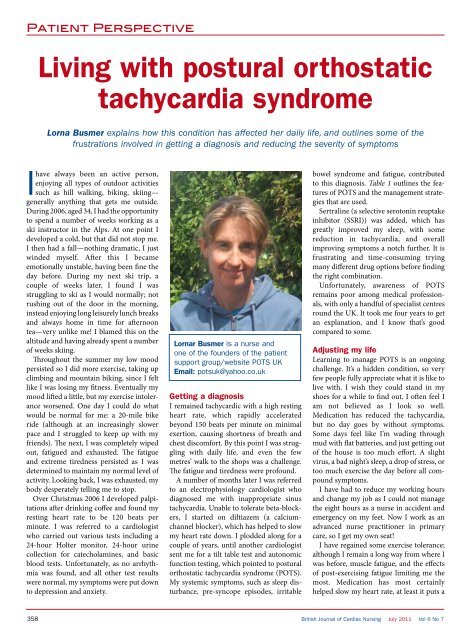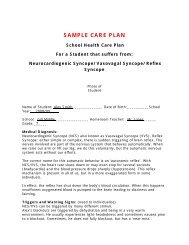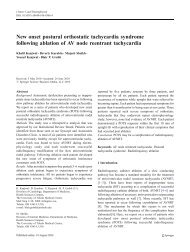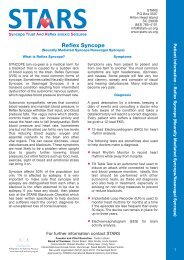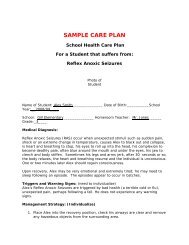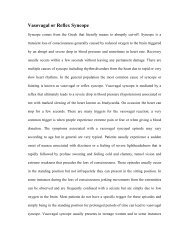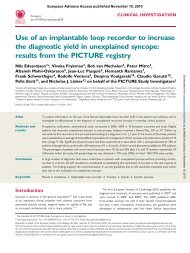Living with postural orthostatic tachycardia syndrome - Internurse
Living with postural orthostatic tachycardia syndrome - Internurse
Living with postural orthostatic tachycardia syndrome - Internurse
- No tags were found...
Create successful ePaper yourself
Turn your PDF publications into a flip-book with our unique Google optimized e-Paper software.
Patient Perspective<strong>Living</strong> <strong>with</strong> <strong>postural</strong> <strong>orthostatic</strong><strong>tachycardia</strong> <strong>syndrome</strong>Lorna Busmer explains how this condition has affected her daily life, and outlines some of thefrustrations involved in getting a diagnosis and reducing the severity of symptomsIhave always been an active person,enjoying all types of outdoor activitiessuch as hill walking, biking, skiing—generally anything that gets me outside.During 2006, aged 34, I had the opportunityto spend a number of weeks working as aski instructor in the Alps. At one point Ideveloped a cold, but that did not stop me.I then had a fall—nothing dramatic, I justwinded myself. After this I becameemotionally unstable, having been fine theday before. During my next ski trip, acouple of weeks later, I found I wasstruggling to ski as I would normally; notrushing out of the door in the morning,instead enjoying long leisurely lunch breaksand always home in time for afternoontea—very unlike me! I blamed this on thealtitude and having already spent a numberof weeks skiing.Throughout the summer my low moodpersisted so I did more exercise, taking upclimbing and mountain biking, since I feltlike I was losing my fitness. Eventually mymood lifted a little, but my exercise intoleranceworsened. One day I could do whatwould be normal for me: a 20-mile bikeride (although at an increasingly slowerpace and I struggled to keep up <strong>with</strong> myfriends). The next, I was completely wipedout, fatigued and exhausted. The fatigueand extreme tiredness persisted as I wasdetermined to maintain my normal level ofactivity. Looking back, I was exhausted, mybody desperately telling me to stop.Over Christmas 2006 I developed palpitationsafter drinking coffee and found myresting heart rate to be 120 beats perminute. I was referred to a cardiologistwho carried out various tests including a24-hour Holter monitor, 24-hour urinecollection for catecholamines, and basicblood tests. Unfortunately, as no arrhythmiawas found, and all other test resultswere normal, my symptoms were put downto depression and anxiety.Lornar Busmer is a nurse andone of the founders of the patientsupport group/website POTS UKEmail: potsuk@yahoo.co.ukGetting a diagnosisI remained tachycardic <strong>with</strong> a high restingheart rate, which rapidly acceleratedbeyond 150 beats per minute on minimalexertion, causing shortness of breath andchest discomfort. By this point I was struggling<strong>with</strong> daily life, and even the fewmetres’ walk to the shops was a challenge.The fatigue and tiredness were profound.A number of months later I was referredto an electrophysiology cardiologist whodiagnosed me <strong>with</strong> inappropriate sinus<strong>tachycardia</strong>. Unable to tolerate beta-blockers,I started on diltiazem (a calciumchannelblocker), which has helped to slowmy heart rate down. I plodded along for acouple of years, until another cardiologistsent me for a tilt table test and autonomicfunction testing, which pointed to <strong>postural</strong><strong>orthostatic</strong> <strong>tachycardia</strong> <strong>syndrome</strong> (POTS).My systemic symptoms, such as sleep disturbance,pre-syncope episodes, irritablebowel <strong>syndrome</strong> and fatigue, contributedto this diagnosis. Table 1 outlines the featuresof POTS and the management strategiesthat are used.Sertraline (a selective serotonin reuptakeinhibitor (SSRI)) was added, which hasgreatly improved my sleep, <strong>with</strong> somereduction in <strong>tachycardia</strong>, and overallimproving symptoms a notch further. It isfrustrating and time-consuming tryingmany different drug options before findingthe right combination.Unfortunately, awareness of POTSremains poor among medical professionals,<strong>with</strong> only a handful of specialist centresround the UK. It took me four years to getan explanation, and I know that’s goodcompared to some.Adjusting my lifeLearning to manage POTS is an ongoingchallenge. It’s a hidden condition, so veryfew people fully appreciate what it is like tolive <strong>with</strong>. I wish they could stand in myshoes for a while to find out. I often feel Iam not believed as I look so well.Medication has reduced the <strong>tachycardia</strong>,but no day goes by <strong>with</strong>out symptoms.Some days feel like I’m wading throughmud <strong>with</strong> flat batteries, and just getting outof the house is too much effort. A slightvirus, a bad night’s sleep, a drop of stress, ortoo much exercise the day before all compoundsymptoms.I have had to reduce my working hoursand change my job as I could not managethe eight hours as a nurse in accident andemergency on my feet. Now I work as anadvanced nurse practitioner in primarycare, so I get my own seat!I have regained some exercise tolerance;although I remain a long way from where Iwas before, muscle fatigue, and the effectsof post-exercising fatigue limiting me themost. Medication has most certainlyhelped slow my heart rate, at least it puts a358 British Journal of Cardiac Nursing July 2011 Vol 6 No 7
Patient Perspectivecap on it, stopping it from going too high;but it does not control the rate of acceleration.I still don’t need to do much for myheart rate to be over 100! As a result, Iknow my muscles do not get adequate oxygen.... and I get very tired.I have had to reset my goals in life andaccept my limited physical capacity, but alsoacknowledge I have done myself a favour bykeeping myself as active as possible.Cycling was my everyday norm, coveringmiles every week. Now it’s an occasionaltreat as the post-exercising fatigue is profound.Skiing is my passion, previously I’d beenaiming to ski better and harder. I stillstruggle when I see my friends, who I usedto ski <strong>with</strong>, doing run after run of highintensityskiing, all day long ... then gettingup the next and doing it all again. Now Ifocus on teaching other people to ski andremain thankful for what I can still achieve.I have taken up new hobbies such asclimbing and pilates as they have a greateremphasis on muscle strength rather thancardiovascular fitness.Climbing is a great way to spend all dayoutside <strong>with</strong> wonderful people, hangingaround on rock. Climbing has beendescribed as ‘an activity for people who donot do activity’. I never used to climb—toomuch sitting around for my liking—preferringa good stomp over the hills as I neededto expend my energy. Now I love it. I havelearnt a new skill, have new friends and I’mthankful that I have found an activity thatis achievable even <strong>with</strong> POTS.With my determination and positiveoutlook, I continue to push myself throughthe fatigue and <strong>tachycardia</strong> to live life tothe full. I have learnt to pace myself, to dothings slowly. I have learnt when to pushthrough symptoms, and when to stop andrest. I enjoy and appreciate everything inlife and continue to be thankful for what Ican do. POTS has opened up new opportunitiessuch as meeting new people, developingnew interests and spending moretime <strong>with</strong> people, which would have neverhappened before.Table 1Postural <strong>orthostatic</strong> <strong>tachycardia</strong> <strong>syndrome</strong>: The basicsPostural <strong>orthostatic</strong> <strong>tachycardia</strong> <strong>syndrome</strong> (POTS) is a condition of the autonomicnervous system. It is characterized by symptoms of <strong>orthostatic</strong> intolerance suchas headaches, fatigue, palpitations, sweating, nausea, syncope, near syncopeand dizziness associated <strong>with</strong> an increase in heart rate from the supine to uprightposition of greater than 30 beats per minute, or a heart rate of greater than 120beats per minute <strong>with</strong>in 10 minutes of standing (Soliman et al, 2010). Diagnosisis usually based on a tilt table test. Other autonomic functions such as digestion,bladder control, temperature control, sweating, and stress responses can also beaffected.POTS has a significant impact on every aspect of life, <strong>with</strong> symptoms and limitationsof daily activity varying from mild to severe (Johnson et al, 2010). Disability canbe equivalent to that found in heart failure, <strong>with</strong> 25% of patients unable to work(Benrud-Larson et al, 2002) and some may be wheelchair-dependant.ManagementPOTS cannot be cured, but <strong>with</strong> the correct medication and appropriate lifestylechanges can be managed, therefore improving quality of life. Non-pharmacologicaltreatment options include increasing fluid and salt, compression stockingsand light to moderate exercise (Grubb et al, 2006). Pharmacological treatmentoptions include fludrocortisone to aid sodium retention and therefore elevateblood pressure; midodrine to constrict the peripheral blood vessles to aid venusreturn; beta-blockers, calcium-channel blockers and ivabradine to slow down heartrate. Selective serotonin reuptake inhibitors (SSRIs) such as sertraline havebeen used, as serotonin plays a part in the control of both heart rate and bloodpressure (Thieben et al, 2007). Sertraline also has the benefit of improving sleepin some patients. Treatments must be highly individualized, as the same drug canhave very different effects on different individuals. People <strong>with</strong> POTS tend to bedrug-sensitive, therefore drugs need to be commenced in tiny doses and effectsmonitored very closely.Further information can be obtained fromPOTS UK: www.potsuk.orgSTARS (Syncope Trust And Reflex anoxia Seizures): www.stars.org.ukI would like to thank Melloney Ferrar,Arrhythmia Care Co-ordinator, and thearrhythmia team, Sheffield, for taking aninterest in POTS, which has made a differenceto the lives of many.Benrud-Larson LM, Dewar MS, Sandroni P,Rummans TA, Haythornthwaite JA, Low PA(2002) Quality of life in patients <strong>with</strong> <strong>postural</strong><strong>tachycardia</strong> <strong>syndrome</strong>. Mayo Clin Proc 77: 531–7Grubb B, Kanjwal Y, Kosinski D (2006) The <strong>postural</strong><strong>tachycardia</strong> <strong>syndrome</strong>: A concise guide to diagnosisand management. J Cardiovasc Electrophysiol17: 108–12Johnson J, Mack K, Kuntz N, Brands C, Porter C,Fisher P (2010) Postural <strong>orthostatic</strong> <strong>tachycardia</strong><strong>syndrome</strong>: A clinical review. Pediatric Neurology,42(2): 77–85Soliman K, Sturman S, Sarkar PK, Michael A(2010) Postural <strong>orthostatic</strong> <strong>tachycardia</strong> <strong>syndrome</strong>(POTS): a diagnostic dilemma. British Journal ofCardiology 17( 1): 36–9Thieben M, Sandroni P, Sletten D et al (2007) Postural<strong>orthostatic</strong> <strong>tachycardia</strong> <strong>syndrome</strong>: The Mayo Clinicexperience. Mayo Clin Proc 82: 308–13British Journal of Cardiac Nursing July 2011 Vol 6 No 7 359


